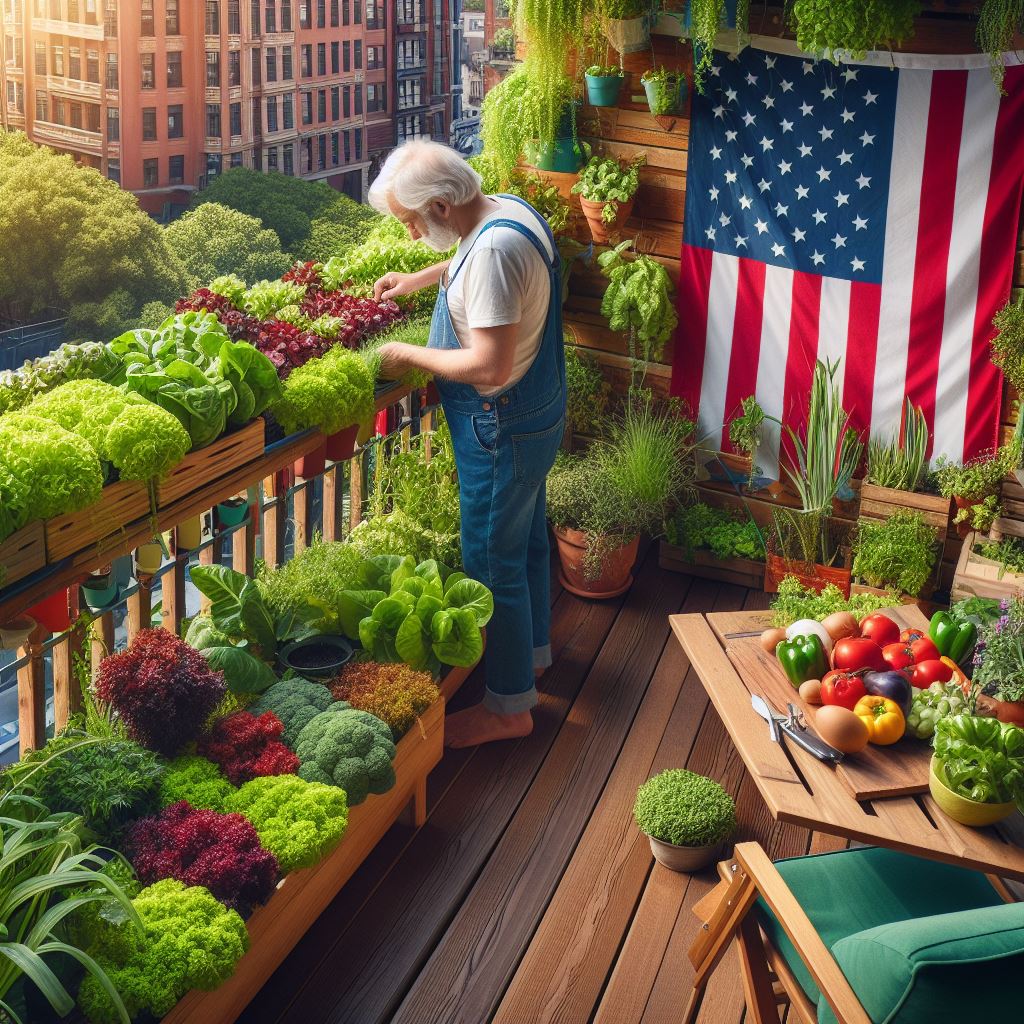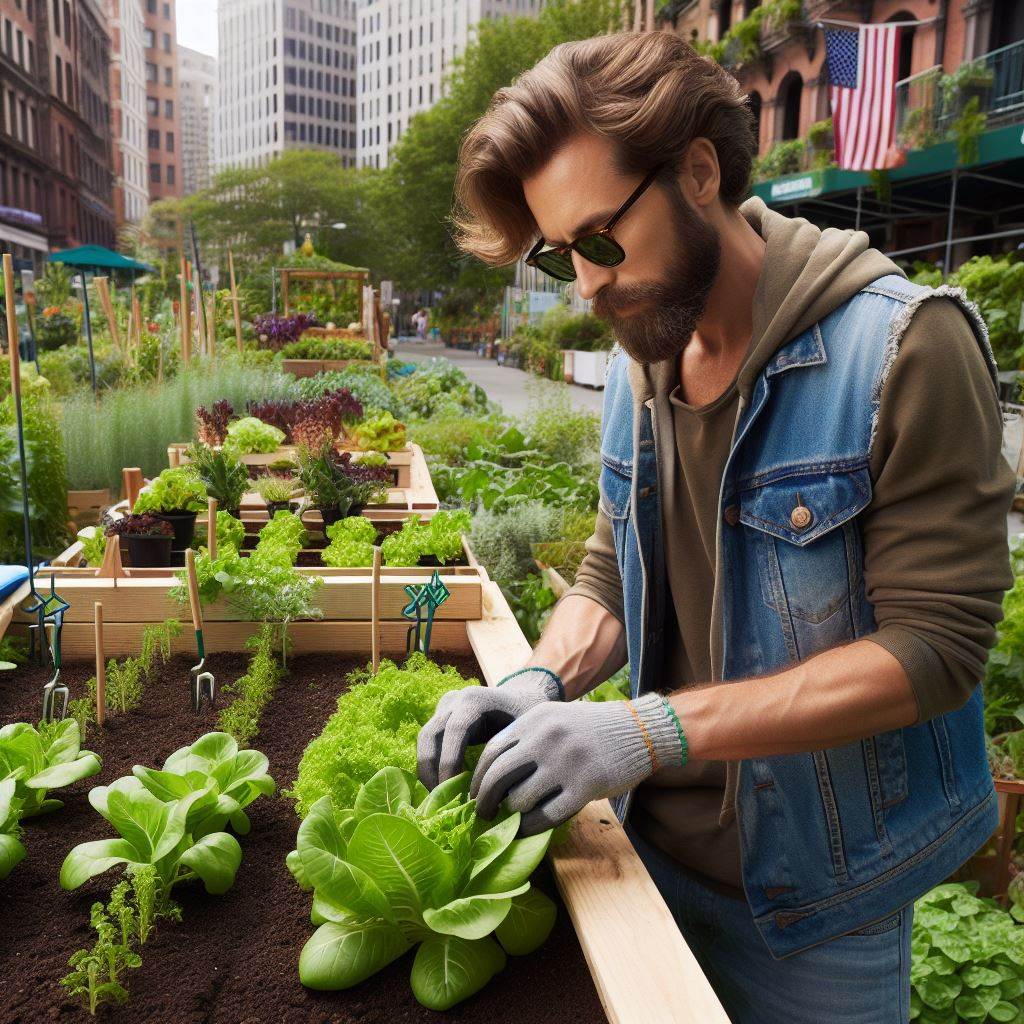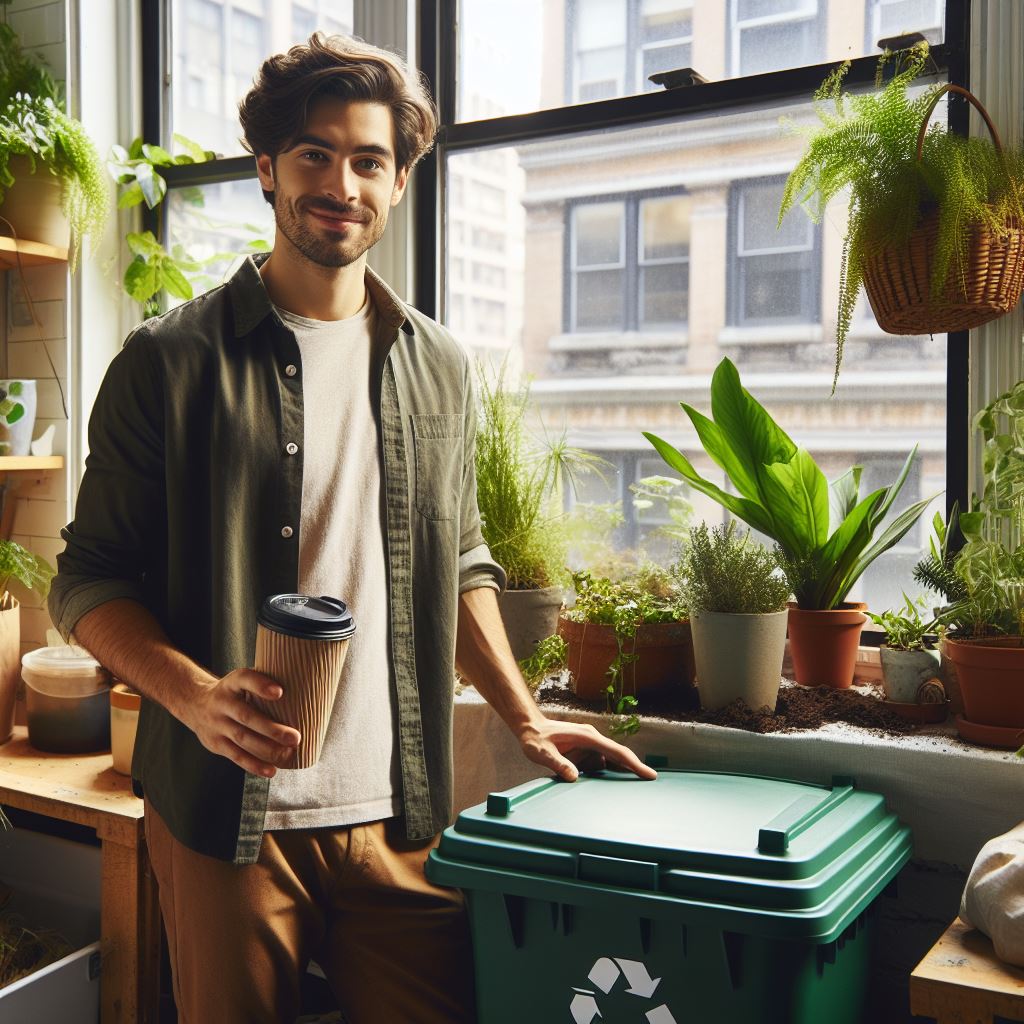Introduction
Balcony veggie gardens are a great way to grow your own food in small spaces.
Balcony veggie gardens involve utilizing the limited space on balconies to grow various types of vegetables.
Importance and benefits of balcony veggie gardens
Balcony veggie gardens offer numerous benefits, such as providing fresh produce, saving money, and promoting sustainability.
By growing vegetables on your balcony, you can have access to fresh, organic produce right at your fingertips.
There is no need to rely on store-bought veggies that may have been treated with pesticides or chemicals.
Having a balcony veggie garden also helps you save money on grocery bills.
Growing your own vegetables means you don’t have to purchase them, leading to significant savings in the long run.
Furthermore, balcony veggie gardens contribute to a sustainable lifestyle.
By growing your own food, you reduce the need for transportation, packaging, and other resources associated with store-bought produce.
This helps to minimize your carbon footprint and promote environmental conservation.
Additionally, balcony veggie gardens provide a sense of satisfaction and fulfillment.
Witnessing the growth and transformation of your plants into fully-grown vegetables is a rewarding experience.
Lastly, balcony veggie gardens can also enhance the overall aesthetic appeal of your space.
The greenery adds a natural and vibrant touch, creating a serene and calming atmosphere.
Basically, balcony veggie gardens are a practical and sustainable way to grow your own food while maximizing the limited space available.
Transform Your Agribusiness
Unlock your farm's potential with expert advice tailored to your needs. Get actionable steps that drive real results.
Get StartedThe benefits of balcony veggie gardens extend from providing fresh produce to promoting a greener and more self-sufficient lifestyle.
Choosing the Right Plants
Factors to consider
Factors to consider when choosing plants for your balcony veggie garden include the size of your balcony, the amount of sunlight it gets, and the climate in your area.
- Size: Take into account the available space on your balcony and choose plants that fit accordingly. Consider vertical gardening to maximize space.
- Sunlight exposure: Observe how much sunlight your balcony receives throughout the day. Some plants require full sun, while others thrive in partial shade.
- Climate: Research the climate in your area and select plants that are suitable for the temperature and conditions. Consider hardiness zones and frost dates.
Ideal Plants for Balcony Veggie Gardens
Certain plants are better suited for growing in balcony veggie gardens due to their size, adaptability, and yield.
Consider the following options:
- Herbs: Basil, parsley, rosemary, and cilantro are popular herbs that can be grown successfully in containers.
- Leafy greens: Lettuce, spinach, kale, and Swiss chard are excellent choices for smaller spaces and can be harvested continuously.
- Tomatoes: Compact tomato varieties, such as cherry tomatoes or determinate varieties, are ideal for containers.
- Peppers: Bell peppers and chili peppers can be successfully grown in pots, provided they receive enough sunlight.
Container Gardening Options
Container gardening offers flexibility and convenience for balcony veggie gardens.
Consider the following container options:
- Pots: Choose pots that are the appropriate size for your plants, ensuring they have drainage holes to prevent waterlogging.
- Hanging baskets: Utilize vertical space by hanging baskets, which can hold a variety of plants such as strawberries or trailing herbs.
- Window boxes: Window boxes can be affixed to balcony railings, providing a narrow but versatile space for planting.
- Grow bags: Lightweight and easy to move around, grow bags are an affordable option for growing vegetables like tomatoes or potatoes.
- Vertical structures: Install trellises, shelves, or wall-mounted planters to maximize vertical space and increase growing area.
Tips and Tricks for Balcony Veggie Gardens
To make the most of your balcony veggie garden, consider these additional tips and tricks:
- Soil: Use high-quality potting soil enriched with compost for optimal plant growth and drainage.
- Watering: Water your plants regularly, but avoid over-watering. Check soil moisture levels by inserting your finger into the soil.
- Feeding: Fertilize your plants with organic plant food to provide necessary nutrients for healthy growth.
- Pest control: Monitor for pests like aphids or snails and take appropriate measures such as using organic insecticides or introducing beneficial insects.
- Pruning: Regularly trim and prune your plants to encourage growth, airflow, and prevent disease.
- Harvesting: Harvest crops at the right time to ensure maximum flavor and quality. Follow plant-specific guidelines for best results.
With the right selection of plants, containers, and gardening techniques, you can create a thriving balcony veggie garden that provides fresh produce right at your doorstep.
Enjoy the benefits of homegrown vegetables while making the most of your limited outdoor space.
Read: City Herbs: Growing Flavor in Tiny Spaces
Preparing the Balcony
Assessing available space
- Measure the balcony’s dimensions to understand the area that can be utilized for gardening.
- Consider the amount of sunlight received and the direction it comes from.
- Take note of any obstructions like railings, windows, or air conditioning units.
Cleaning and clearing the area
- Sweep the floor, remove any trash or clutter, and wipe down surfaces.
- Scrub balcony rails and walls if necessary to get rid of dirt or grime.
- Consider using plant stands or shelves to maximize space and keep the area organized.
Checking for safety and stability
- Inspect the balcony’s structure for any weak or damaged areas.
- Ensure railings are secure and sturdy enough to support the weight of plants.
- If uncertain, consult a professional to evaluate the balcony’s safety for gardening purposes.
Soil and Fertilizer
When it comes to creating a successful balcony veggie garden, soil and fertilizer are key factors to consider.
In this section, we will explore the importance of selecting the right soil for containers, tips for improving soil quality, and organic fertilizer options.
Selecting the right soil for containers
- Look for a high-quality potting mix that is specifically designed for container gardening.
- Avoid using garden soil, as it may not have the proper balance of nutrients and drainage.
- Consider using a mix that contains peat moss, perlite, and vermiculite for optimal moisture retention and drainage.
- Check the pH level of the soil and ensure it is suitable for the vegetables you want to grow.
Tips for improving soil quality
- Mix in compost to improve the fertility and structure of the soil. Compost adds organic matter and beneficial microbes.
- Consider adding organic matter such as leaf mold or well-rotted manure to enhance the nutrient content.
- Regularly aerate the soil by gently loosening it with a garden fork to improve drainage and root development.
- Use organic mulch, like straw or wood chips, to regulate soil temperature, reduce water evaporation, and suppress weeds.
Organic fertilizer options
- Utilize compost tea by steeping compost in water for a few days, then strain out the solids and use the liquid to fertilize your plants.
- Fish emulsion is a great organic fertilizer option that provides a good source of nitrogen and other essential nutrients.
- Seaweed and kelp extracts are rich in trace minerals and can improve overall plant health and resilience.
- Blood meal and bone meal are slow-release fertilizers that provide a good source of nitrogen and phosphorus respectively.
- Consider using organic pelletized fertilizers that slowly release nutrients over time, providing a steady supply to your plants.
Remember, when it comes to fertilizer, it’s important not to overdo it.
Start with smaller amounts and gradually increase as needed, following the instructions on the packaging.
It’s always better to err on the side of caution to avoid nutrient burn or other problems.
In essence, selecting the right soil for containers, improving soil quality, and choosing organic fertilizers are vital elements for a successful balcony veggie garden.
By providing your plants with the proper environment and nutrients, you can ensure bountiful harvests and healthy plants.
Experiment with different approaches and find what works best for your specific balcony garden.
Happy gardening!
Read: Watering Tips for Small Gardens & Farms
Container Selection and Placement
Types of containers suitable for balcony veggie gardens
- Hanging baskets
- Pots or planters
- Window boxes
- Vertical planters
Determining the number and size of containers needed
- Consider the types and quantity of vegetables you want to grow
- Ensure containers have enough space for plants to grow
- Make sure containers have drainage holes to prevent waterlogged soil
Proper placement for optimal sunlight exposure
- Place containers in an area that receives at least 6-8 hours of sunlight per day
- Avoid placing containers in areas with excessive wind or shade
- Consider using trellises or stakes to ensure plants receive sufficient sunlight
When it comes to balcony veggie gardens, the right container selection and placement are crucial for the success of your plants.
Here are some tips and tricks to help you make the best choices.
Types of containers suitable for balcony veggie gardens
There are several options available that work well for growing vegetables on your balcony.
Hanging baskets are great for trailing plants like cherry tomatoes and herbs.
Showcase Your Farming Business
Publish your professional farming services profile on our blog for a one-time fee of $200 and reach a dedicated audience of farmers and agribusiness owners.
Publish Your ProfilePots or planters provide more space and can accommodate a variety of vegetables.
Window boxes are ideal for small balconies with limited space. Vertical planters allow you to maximize your planting area by utilizing wall space.
Determining the number and size of containers needed
Before getting started, consider the types and quantity of vegetables you want to grow.
This will help you determine how many containers you will need.
It’s important to give your plants enough space to grow, so choose containers that are large enough to accommodate their roots and growth potential.
Additionally, make sure the containers have drainage holes to prevent waterlogged soil, which can lead to root rot.
Proper placement for optimal sunlight exposure
Sunlight is essential for the healthy growth of your plants.
Find a location on your balcony that receives at least 6-8 hours of direct sunlight per day.
Avoid placing your containers in areas with excessive wind or shade, as this can negatively impact plant growth.
If your balcony doesn’t receive enough sunlight, consider using trellises or stakes to position your plants in a way that maximizes sun exposure.
Essentially, when setting up your balcony veggie garden, choose the right containers for the job, consider the number and size of containers based on your vegetable selection, and ensure proper placement for optimal sunlight exposure.
Following these tips and tricks will set you on the path to a successful and bountiful harvest from your balcony veggie garden.
Read: Seasonal Planting Strategies for Hobbyists

Watering and Drainage
Importance of proper watering
Proper watering is crucial for the health and growth of plants in balcony veggie gardens.
Overwatering or underwatering can lead to root rot or plant dehydration respectively.
To ensure proper watering, always check the moisture level of the soil before watering.
Techniques for watering balcony veggie gardens
Techniques like drip irrigation or using a watering can with a narrow spout can help deliver water directly to the plant’s roots.
Watering in the morning or evening is preferable as it reduces water loss due to evaporation.
Drainage solutions to prevent water buildup
Remember, maintaining the right balance between watering and drainage is key to a thriving balcony veggie garden.
Creating a drainage system is essential to prevent water buildup, which can cause plant stress and root suffocation.
Elevating pots with the help of plant stands or bricks can allow excess water to drain freely.
Adding a layer of gravel or pebbles at the bottom of the pots can improve drainage.
Consider using self-watering containers that have built-in drainage systems to maintain the right moisture level.
Be mindful of the types of pots or containers used, as some materials may retain water more than others.
Regularly check for any clogs in the drainage holes and clear them to ensure uninterrupted water flow.
Adjust watering frequency based on environmental factors such as temperature, humidity, and rainfall patterns.
Incorporating organic matter like compost or perlite into the soil can enhance drainage capacity.
Mulching the surface of the soil with materials like straw or wood chips can help retain soil moisture while preventing waterlogging.
Monitoring and maintaining proper soil moisture levels is essential to avoid both underwatering and overwatering.
Read: Balcony Gardens: Growing in Small Spaces
Pests and Diseases
Common pests and diseases affecting balcony veggie gardens
Pests and Diseases in Balcony Veggie Gardens Even small balcony veggie gardens can be susceptible to pests like aphids, snails, and caterpillars.
These critters can quickly ravage vegetable plants and fruits.
Common plant diseases like powdery mildew, blights, and rust can also wreak havoc.
Diligent monitoring and prompt action are key to preventing major infestations and infections.
Prevention and control methods
Check plants frequently for early signs of pests like chewed leaves or presence of bugs.
Handpick pests off plants whenever spotted.
Use row covers or nettings to exclude pests.
Introduce beneficial insects like ladybugs and lacewings which prey on plant pests.
Remove diseased parts immediately and avoid overhead watering which spreads spores.
Apply natural pest deterrents like neem oil, insecticidal soap, or horticultural oils.
Showcase Your Farming Business
Publish your professional farming services profile on our blog for a one-time fee of $200 and reach a dedicated audience of farmers and agribusiness owners.
Publish Your ProfileGarlic, onion, and chili pepper sprays also repel many pests.
Diatomaceous earth sprinkled around plants will shred soft-bodied insects.
Trap slugs and snails with beer in shallow containers sunk into the soil.
For Disease Prevention
For disease prevention, improve air circulation and avoid wetting foliage.
Allow soil to dry between waterings. Fertilize minimally and prune to open up thick growth.
Sanitize tools and hands frequently when handling plants.
With vigilant monitoring and organic pest control, balcony veggie gardens can thrive pest and disease free.
Maintenance and Harvesting
Regular maintenance tasks
Regular maintenance tasks on a balcony veggie garden include pruning, weeding, and fertilizing.
Pruning is important to promote healthy growth and prevent overcrowding of plants on the balcony.
Weeding should be done regularly to remove any unwanted plants that may compete with the vegetables for nutrients and space.
Fertilizing is essential to provide the necessary nutrients for the plants to thrive in a limited space.
Harvesting tips for different vegetables
Harvesting tips vary for different vegetables grown on a balcony.
Leafy greens such as lettuce and spinach can be harvested by picking the outer leaves while leaving the inner ones to continue growing.
Tomatoes should be harvested when they are fully red and firm, but not overly ripe.
Cucumbers should be harvested when they are green and at the desired size.
Monitoring and addressing plant health issues
Monitoring the health of plants is crucial to prevent and address any potential issues.
Regularly check for signs of pests or diseases, such as wilting leaves, discolored spots, or holes in the leaves.
If any plant health issues are detected, take immediate action by removing infected leaves or using organic pest control methods.
Creating a conducive environment for plants is also essential for their health and productivity.
Provide adequate sunlight by placing the vegetable garden in a spot that receives at least 6 hours of direct sunlight.
Water the plants regularly, ensuring that the soil is evenly moist but not waterlogged.
Ensure proper drainage to prevent waterlogged roots, which can lead to root rot and other diseases.
Using organic fertilizers and compost can enhance the soil fertility and promote healthy plant growth.
Utilize companion planting to maximize space and repel pests.
Example
For example, planting marigolds near tomatoes can repel aphids and other insects.
Consider rotating crops annually to prevent the depletion of soil nutrients and minimize the risk of pests and diseases.
Regularly clean and inspect the balcony environment to prevent the build-up of debris and potential breeding grounds for pests.
Keep tools clean and organize all gardening materials to ensure easy access and functionality.
Protect the plants from extreme weather conditions, such as strong winds or excessive heat, by using screens or planting them near walls.
In a nutshell, maintaining a balcony veggie garden requires regular pruning, weeding, and fertilizing.
Harvesting tips should be followed for different vegetables, and plant health issues should be monitored and addressed promptly.
Creating a conducive environment, practicing companion planting, and proper cleanliness are also important for a successful balcony veggie garden.
You Might Also Like: Balancing Act: Aquaponic System Tips
Conclusion
We have discussed several tips and tricks for successful balcony veggie gardens.
First, choose the right plants that thrive in containers and have a small root system.
Next, ensure proper drainage by using a well-draining soil mix and adding pebbles or gravel to the bottom of your containers.
Remember to water your plants regularly, keeping in mind that container plants may require more frequent watering.
Provide adequate sunlight by placing your containers in a sunny spot on your balcony.
Fertilize your plants with a balanced organic fertilizer to promote healthy growth.
Pest control is important, so monitor your plants regularly for signs of pests and take appropriate measures to control them.
Showcase Your Farming Business
Publish your professional farming services profile on our blog for a one-time fee of $200 and reach a dedicated audience of farmers and agribusiness owners.
Publish Your ProfileLastly, always harvest your veggies when they are ripe to enjoy the freshest flavors.
We encourage all readers to try balcony gardening, as it is a rewarding and sustainable way to grow your own food.
Even if you have a small space, you can still enjoy the benefits of fresh and organic produce.
Share your experiences and tips with others by joining online gardening communities or starting your own balcony veggie garden blog.
Together, we can inspire and support each other in creating beautiful and bountiful urban gardens. Happy gardening!




